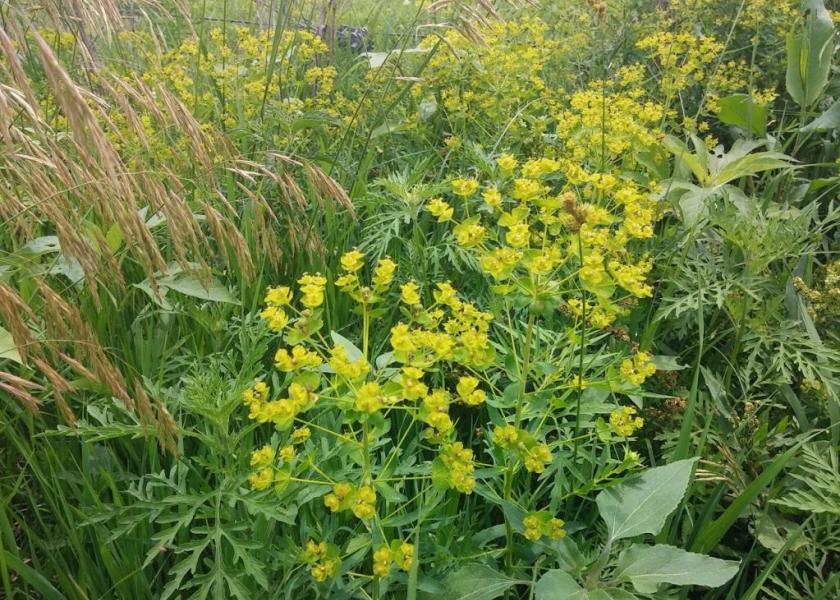Controlling Weeds in Pastures and Rangeland

As temperatures finally warm up and we get close to turning animals out to pasture, keep an eye out for possible weed issues that may arise during the growing season. Surveying and keeping a record of weed locations over the course of the year is something every producer should keep in the back of their mind as they travel across pastures getting fence and water ready and checking cattle.
Early and correct identification of pasture weeds is the first step in maintaining a healthy pasture. Control techniques for a winter annual are different than a biennial or perennial species. If you are unsure of a particular plant in your pasture, bring it into your local extension office for assistance with identification.
Often times, weedy species will establish themselves in stressed areas of the pasture. Areas that have been over-grazed, flooded, have heavy traffic, or were drought stressed are good spots to look at first.
Another place to keep an eye on is where any hay was fed over the winter, especially if bales were purchased or brought in from outside your operation. With the outpouring of support for those hit by flooding this spring, hay from all over the U.S. has been loaded up and shipped to Nebraskans in need. While no one is purposefully sharing hay that might contain weeds, there may be a few seeds that were able to sneak along for the ride. Additionally, plants in other parts of the U.S. that may not be invasive in their native habitat may become aggressive under the conditions found in Nebraska. Keeping track of where those bales were fed and monitoring throughout the year will help catch possible problems early. Cows can spread seeds in their manure as well, so allow cows to clean out after eating those bales before moving them to another site.
Once we know what weed issues we will face, deciding on what control measures to take is the next step. In some cases, weeds are just exploiting stressed areas and can be pushed out by improving pasture health and allowing desired species to recover.
Another thing to consider is if the weeds we see as a problem, may actually be an opportunity. Animals like goats and sheep prefer shrub and broadleaf plants for their diet and may be added into an operation to utilize plant species that would otherwise be considered unpalatable from a cow’s point of view. Done properly, multi-species operations can control weeds and open up a new revenue stream without impacting the established beef production.
If control measures do need to be taken, keep the following points in mind:
- Winter annuals (example: Downy Brome/Cheatgrass)
- These plants germinate in the fall and overwinter with rapid growth and maturity in the spring as temperatures warm.
- Fall control is ideal, as the window for proper control in the spring is short. Spring control can be effective if you are able to hit this narrow period between green-up and seed production.
- Summer annuals (examples: Marestail, Russian Thistle, Foxtails, Barnyard Grass)
- Native forbs like sunflowers may sometimes be called a weed, but typically will not be aggressive enough to impact pasture production enough where control measures are needed. Introduced species like the examples above are more aggressive and may justify targeted control. However, improving overall pasture health can increase the vigor of desired species and out compete weedy plants without having to resort to active control.
- Germination occurs over an extended period during the summer, so total control is difficult. Control when plants are young and prevent seed development to reduce numbers over time.
- Biennials (examples: Musk Thistle, Plumeless Thistle)
- Germinated during the summer and form a rosette during year one. As this growth is low to the ground, it will often go unnoticed.
- Reserves built up during year one allow for quick growth and seed production the following year.
- Control during early bloom when regrowth from basil buds will be minimal, but before viable seed can be produced.
- Perennials (examples: Leafy Spurge, Canada Thistle, Spotted and Diffuse Knapweed)
- Plants develop energy stores in root systems that allow for regrowth, even after multiple control attempts.
- Reproduce through seed production, but often also with underground shoots, so controls like tillage may not be effective.
- Stressing the plant and depleting reserves is key. Control right before or at early bloom when spring reserves are depleted by plant growth and flower production. Repeat control in fall before frost to add additional stress as the plant is storing reserves for the winter.
- Shrubs
- Growth occurs from axillary buds (only above ground)
- Example: cedar
- Effective control by removing or killing the growing points through cutting at the base, herbicides, or fire.
- Growth occurs from basil buds (below ground shoots)
- Examples: Sumac, Locust
- Plants have the ability to regrow from buds below the soil surface.
- Control methods that only target above ground growth are ineffective. Pulling up the entire plant, roots and all, or chemical control methods are preferred.
- Growth occurs from axillary buds (only above ground)
Producers that are looking to utilize herbicides for weed control should access Extension Circular 150, 2019 Guide for Weed, Disease, and Insect Management in Nebraska either online or at their local extension office. Pages 148-150 have a list of recommended herbicides and their effectiveness for controlling common range and pasture weeds.







